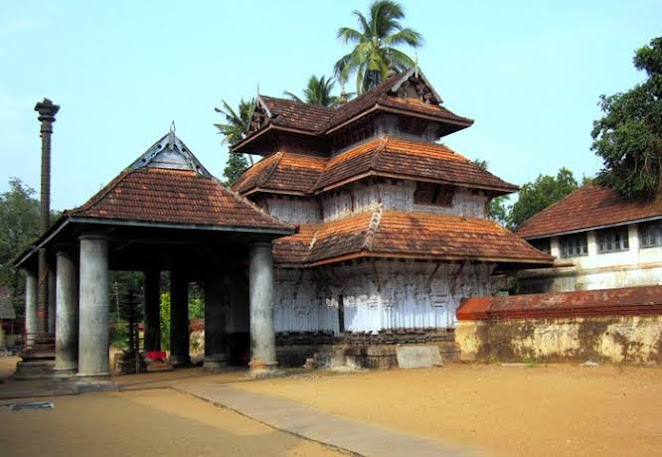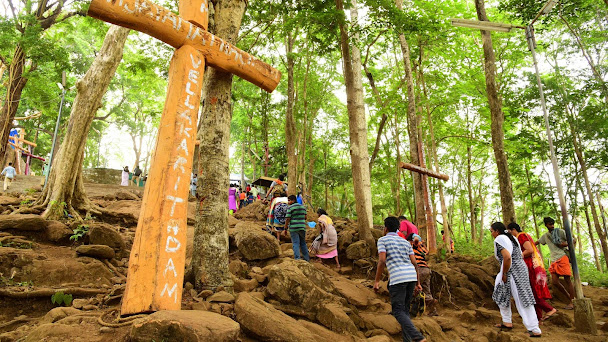The majestic Thiruvanchikulam temple
As per Hindu beliefs there are 108 divya desams which are abodes of Lord Vishnu which is a belief in the Vaishnavite sect. According to the canonical work of Tamil Shaiva poets called Nayanmars in the 7th century there are in all 276 Shiva temples which have a divinity similar to the divya desams & these are listed in their work called Paadal Petra Sthalam. The Thiruvanchikulam Mahadeva temple is the only shrine that finds its place in this celebrated work. The temple is a place of beautiful architecture & has a story that is related to the uniqueness of the deity.
The tutelary deity at the temple here is Lord Shiva in the most serene form called Sadashiv & is in the company of his beloved consort in the form of Umadevi. It is also said that the idol of the Lord is in the form of Umamaheswara. The earlier temple structure is said to have been built during the Chera rule & was completed by the most respected ruler Cheraman Perumal. The exact date of its construction is not clear as the temple has been witness to many reconstructions over the centuries. The temple reverence spread around the lands due to the unique characteristics of the deity itself. The temple has a palliyara or sleeper chamber for the deity which is not commonly seen in Hindu temples. As per ritual the idols of Shiva & Parvathy are placed in the palliyara post the evening pujas. The Palliyara is said to have a sleeping bed & pillows just how a chamber would be and the couple rest in the room until the next morning. This belief is based on the thought that the deity here is a grihastha & so post the duty as a God returns to his role of a husband. This ritual is quite unique as most idols in the Hindu temples are never taken out of the sanctum apart from festival pujas. In the morning the idols are taken out of the Palliyara & placed back in the sanctum for the devotees to pray.
It is also important to know that this is the temple with the largest number of sub-gods or upadevatas. The presence of upadevatas are such that even Cheraman Perumal & his dear friend Sundara Murthy are an upadevata here having shrines as they are credited to have left for Kailasa in search of truth. The Chera kingdom flourished for over 7 centuries until the Kulasekharas took over. The Kulasekhara kings decided to build their capital at this place around the temple, calling it Mahadayapuram. The capital was built such that the city was spread around the walls of the Thiruvanchikulam temple.
The temple kept changing hands between the Cochin Raja & Zamorin for centuries until the Dutch took control. The Dutch army is said to have destroyed the temple in 1670 by pulling down a part of the temple structure & in this event it is said that the sword gifted by Cheraman Perumal to Zamorin before he left to Mecca broke & was lost. It is to be also noted that Tipu sultan and his Mysore army invaded Malabar destroying many temples & the Thiruvanchikulam temple too felt his wrath. Tipu’s soldiers entered the temple & destroyed the whole copper roofing while looting the valuables of the temple. It was only in 1801 that the current temple was built to its current beauty with the assistance of the local Kings. The idol at the temple is said to have been brought from the Chidambaram temple & the consecration of the idol along with the construction was done under the supervision of Paliath Achan of the Cochin Kingdom.
The architecture of the temple is based on the traditional Kerala style of building temples with the square shaped sanctum housing the central shrine where the presiding deity is placed. At the temple apart from the large towers around its compound one feature that strikes any person is the namaskara mandapam which has 16 pillars in front of the sreekovil & is truly a work of great craftsmanship. The temple is also a place where one can see some of the most beautiful temple murals depicting stories from the epics. The carvings around & the sculptures seen along the temple walls are a beautiful work of art. The temple apart from the central shrine is surrounded on all sides by many sub shrines. The temple is such a great example of exemplary architecture & heritage value that the Archaeological Survey of India has listed the Thiruvanchikulam temple as a protected monument.
The temple apart from its relation to the Chidambaram temple also has a close connection with the Chottanikkara Bhagavathy temple as during the bharani festival in Chottanikkara it is necessary for all the participants to pray at the Thiruvanchikulam temple to get blessings for a good performance. As per beliefs it is important for all who seek a loving spouse or parents who seek a child to pray to the deity during the palliyara pujas as that is the time when Lord Shiva is at his most benevolent disposition. The temple celebrates the Mahashivaratri with pomp & all festivities. The 8 days annual festival at the temple is a sight of great beauty in itself where it is a tradition to conduct the Anayottam or Elephant race.
The Thiruvanchikulam temple along with many other places of religious importance in Kodungallur make the place a tolerant land where the presence of different communities helped in moulding the culture of Kerala for future generations. The heritage of the land along with the divinity of the temple is what one needs to experience & can be done only by a visit at the temple.




Comments
Post a Comment